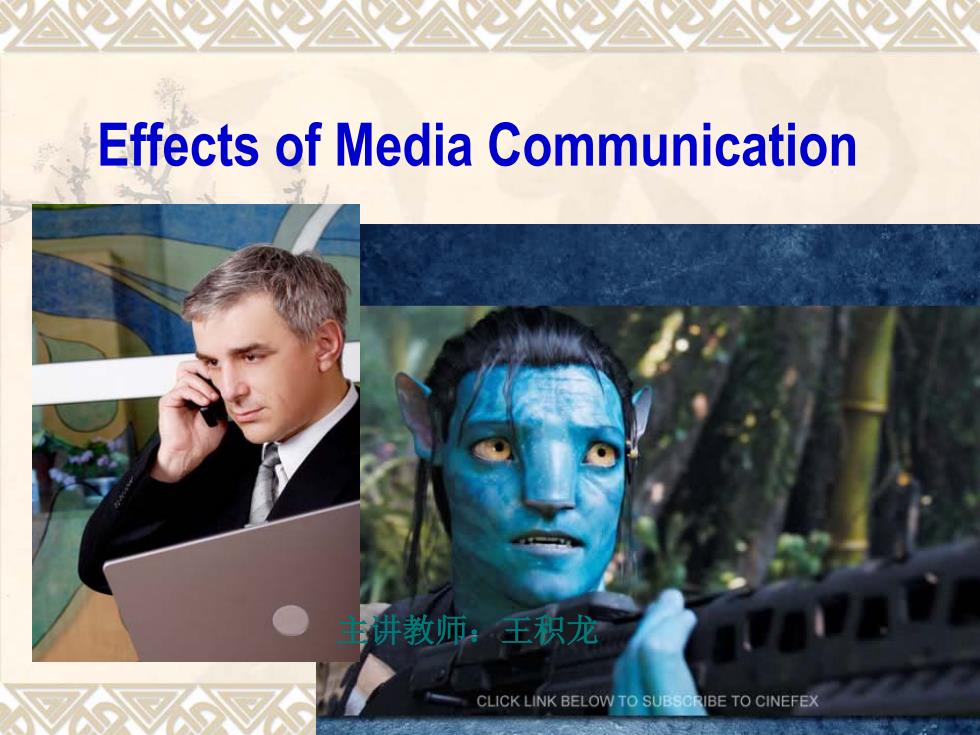
Effects of Media Communication 玉讲教师:王积龙 CLICK LINK BELOW TO SUBSCRIBE TO CINEFEX
Effects of Media Communication 主讲教师:王积龙
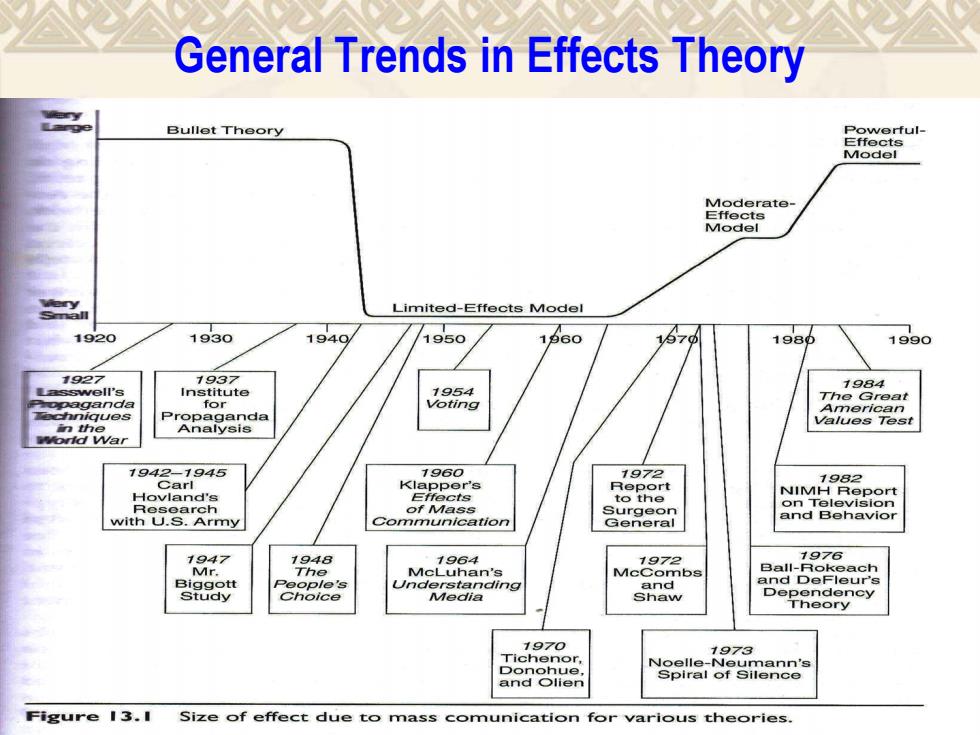
General Trends in Effects Theory Bullet Theory Model Moderate- Effects Model Limited-Effects Model 1920 1930 1940 1950 160 167 198p 1990 1927 19.37 1984 sswell's Institute 1954 ppaganda for Voting The Great Propaganda 198a195 1960 1972 Report Communicaton to the 8 1947 98 1976 Mr. Biggott Peoole's Unde Study ○hoice 1970 1973 Tichenor, Noelle Donohue, and Olien Spiral of Figure 13.I Size of effect due to mass comunication for various theories
General Trends in Effects Theory

Magic Bullet Theory The classic example of the application of the Magic Bullet Theory was illustrated on October 30,1938 when Orson Welles and the newly formed Mercury Theater group broadcasted their radio edition of H.G.Wells'"War of the Worlds."On the eve of Halloween,radio programming was t interrupted with a "news bulletin"for the first time.What the audience heard was that Martians had begun an invasion of Earth in a place called Grover's Mill,New Jersey. It became known as the"Panic Broadcast"and changed broadcast history,social psychology,civil defense and set a standard for provocative entertainment.Approximately 12 million people in the United States heard the broadcast and about one million of those actually believed that a serious alien invasion was underway.A wave of mass hysteria disrupted households,interrupted religious services,caused traffic jams and clogged communication systems.People fled their city homes to seek shelter in more rural areas,raided grocery stores and began to ration food.The nation was in a state of chaos,and this broadcast was the cause of it
The classic example of the application of the Magic Bullet Theory was illustrated on October 30, 1938 when Orson Welles and the newly formed Mercury Theater group broadcasted their radio edition of H.G. Wells' "War of the Worlds." On the eve of Halloween, radio programming was interrupted with a "news bulletin" for the first time. What the audience heard was that Martians had begun an invasion of Earth in a place called Grover's Mill, New Jersey. It became known as the "Panic Broadcast" and changed broadcast history, social psychology, civil defense and set a standard for provocative entertainment. Approximately 12 million people in the United States heard the broadcast and about one million of those actually believed that a serious alien invasion was underway. A wave of mass hysteria disrupted households, interrupted religious services, caused traffic jams and clogged communication systems. People fled their city homes to seek shelter in more rural areas, raided grocery stores and began to ration food. The nation was in a state of chaos, and this broadcast was the cause of it. Magic Bullet Theory
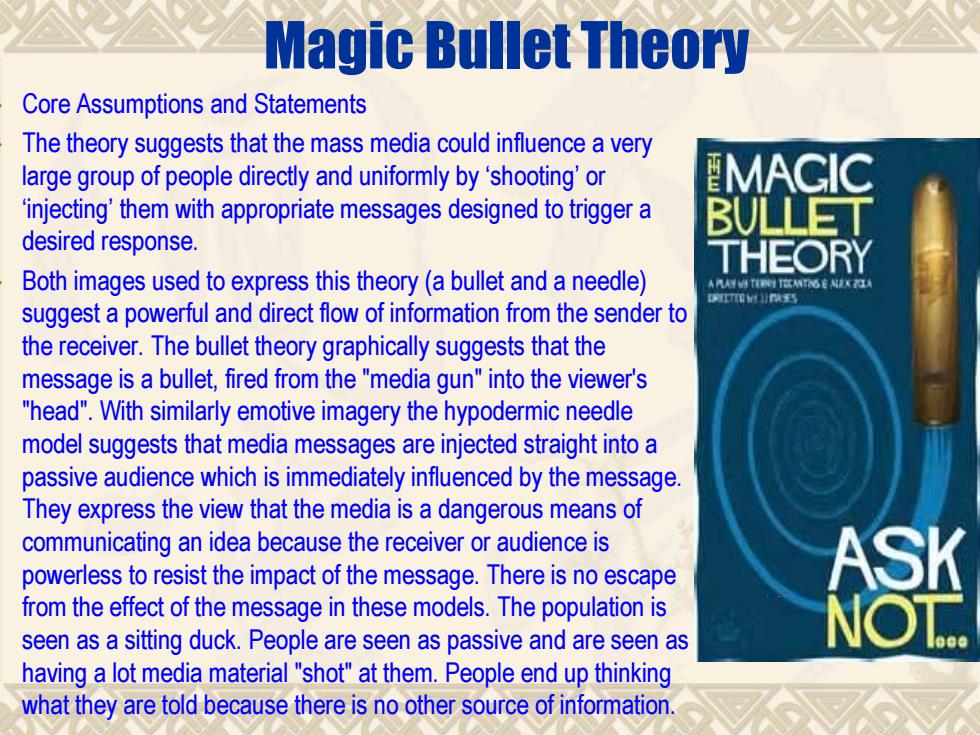
Magic Bullet Theory Core Assumptions and Statements The theory suggests that the mass media could influence a very large group of people directly and uniformly by'shooting'or EMAGIC 'injecting'them with appropriate messages designed to trigger a desired response. THEORY Both images used to express this theory(a bullet and a needle) 鲜ES suggest a powerful and direct flow of information from the sender to the receiver.The bullet theory graphically suggests that the message is a bullet,fired from the"media gun"into the viewer's "head".With similarly emotive imagery the hypodermic needle model suggests that media messages are injected straight into a passive audience which is immediately influenced by the message. They express the view that the media is a dangerous means of communicating an idea because the receiver or audience is powerless to resist the impact of the message.There is no escape ASK from the effect of the message in these models.The population is seen as a sitting duck.People are seen as passive and are seen as having a lot media material "shot"at them.People end up thinking what they are told because there is no other source of information
Core Assumptions and Statements The theory suggests that the mass media could influence a very large group of people directly and uniformly by ‘shooting’ or ‘injecting’ them with appropriate messages designed to trigger a desired response. Both images used to express this theory (a bullet and a needle) suggest a powerful and direct flow of information from the sender to the receiver. The bullet theory graphically suggests that the message is a bullet, fired from the "media gun" into the viewer's "head". With similarly emotive imagery the hypodermic needle model suggests that media messages are injected straight into a passive audience which is immediately influenced by the message. They express the view that the media is a dangerous means of communicating an idea because the receiver or audience is powerless to resist the impact of the message. There is no escape from the effect of the message in these models. The population is seen as a sitting duck. People are seen as passive and are seen as having a lot media material "shot" at them. People end up thinking what they are told because there is no other source of information. Magic Bullet Theory
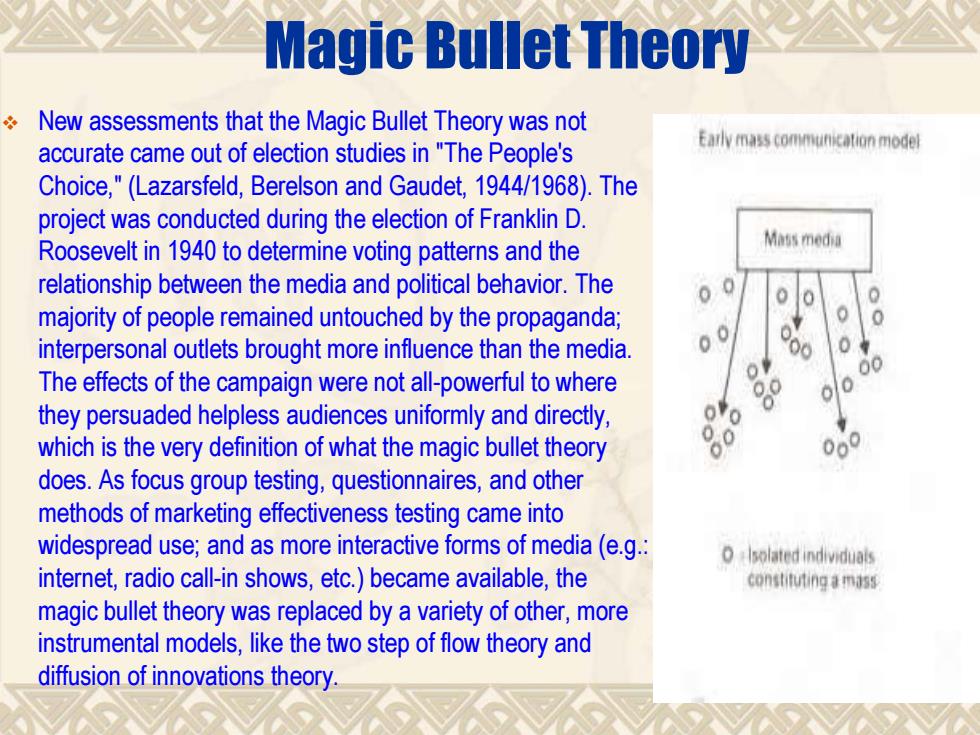
Magic Bullet Theory New assessments that the Magic Bullet Theory was not accurate came out of election studies in "The People's Early mass(ouh减tion model Choice,"(Lazarsfeld,Berelson and Gaudet,1944/1968).The project was conducted during the election of Franklin D Roosevelt in 1940 to determine voting patterns and the Mass media relationship between the media and political behavior.The 0 0 0 majority of people remained untouched by the propaganda; 0 0 interpersonal outlets brought more influence than the media 00 00 0 00 The effects of the campaign were not all-powerful to where 00 they persuaded helpless audiences uniformly and directly, '0 which is the very definition of what the magic bullet theory %0 0o0 does.As focus group testing,questionnaires,and other methods of marketing effectiveness testing came into widespread use;and as more interactive forms of media(e.g.: 0,solatedndivdu的 internet,radio call-in shows,etc.)became available,the constituting a mass magic bullet theory was replaced by a variety of other,more instrumental models,like the two step of flow theory and diffusion of innovations theory
New assessments that the Magic Bullet Theory was not accurate came out of election studies in "The People's Choice," (Lazarsfeld, Berelson and Gaudet, 1944/1968). The project was conducted during the election of Franklin D. Roosevelt in 1940 to determine voting patterns and the relationship between the media and political behavior. The majority of people remained untouched by the propaganda; interpersonal outlets brought more influence than the media. The effects of the campaign were not all-powerful to where they persuaded helpless audiences uniformly and directly, which is the very definition of what the magic bullet theory does. As focus group testing, questionnaires, and other methods of marketing effectiveness testing came into widespread use; and as more interactive forms of media (e.g.: internet, radio call-in shows, etc.) became available, the magic bullet theory was replaced by a variety of other, more instrumental models, like the two step of flow theory and diffusion of innovations theory. Magic Bullet Theory
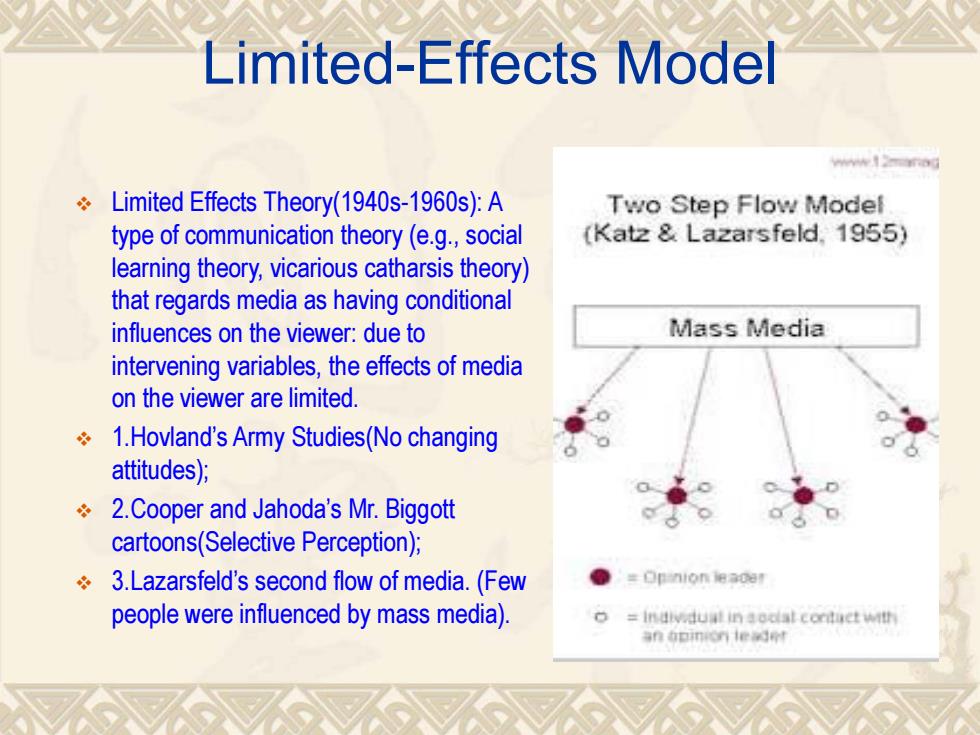
Limited-Effects Model Limited Effects Theory(1940s-1960s):A Two Step Flow Model type of communication theory (e.g.,social (Katz Lazarsfeld.1955) learning theory,vicarious catharsis theory) that regards media as having conditional influences on the viewer:due to Mass Media intervening variables,the effects of media on the viewer are limited. 1.Hovland's Army Studies(No changing attitudes); 2.Cooper and Jahoda's Mr.Biggott cartoons(Selective Perception); 3.Lazarsfeld's second flow of media.(Few 生0pn1onea0e people were influenced by mass media). Indiv duul in aodal cortuct witt n0卫n0neg
Limited-Effects Model Limited Effects Theory(1940s-1960s): A type of communication theory (e.g., social learning theory, vicarious catharsis theory) that regards media as having conditional influences on the viewer: due to intervening variables, the effects of media on the viewer are limited. 1.Hovland’s Army Studies(No changing attitudes); 2.Cooper and Jahoda’s Mr. Biggott cartoons(Selective Perception); 3.Lazarsfeld’s second flow of media. (Few people were influenced by mass media)

Limited-Effects Model The media may cause change within the audience as intended by the communicator,a result called conversion. The media may cause unintended change within an audience. The media may cause change that is only minor in form,intensity or duration.. The media may facilitate change(intended or not)that is actually caused by other social factors. The media may support the status quo, sustaining an audience in its beliefs or behavior rather than causing change.This is known as reinforcement. Finally,the media may prevent change,often through the propagandistic use of one-sided information aimed at an audience that would otherwise embrace change if it had all of the relevant information
Limited-Effects Model The media may cause change within the audience as intended by the communicator, a result called conversion. The media may cause unintended change within an audience. The media may cause change that is only minor in form, intensity or duration.. The media may facilitate change (intended or not) that is actually caused by other social factors. The media may support the status quo, sustaining an audience in its beliefs or behavior rather than causing change. This is known as reinforcement. Finally, the media may prevent change, often through the propagandistic use of one-sided information aimed at an audience that would otherwise embrace change if it had all of the relevant information
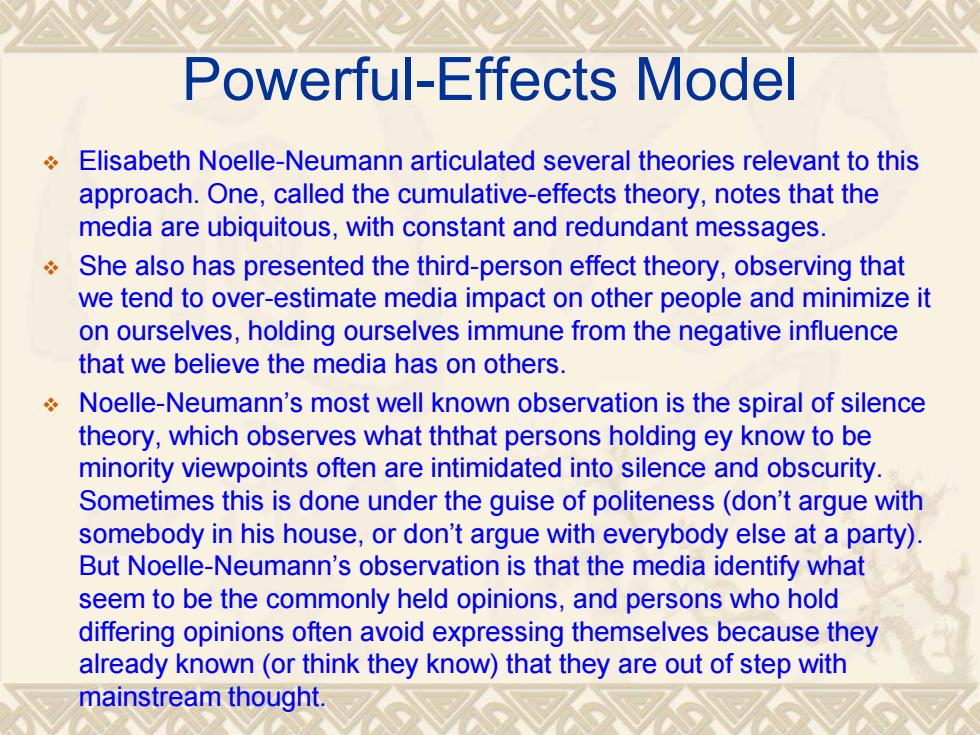
Powerful-Effects Model Elisabeth Noelle-Neumann articulated several theories relevant to this approach.One,called the cumulative-effects theory,notes that the media are ubiquitous,with constant and redundant messages. She also has presented the third-person effect theory,observing that we tend to over-estimate media impact on other people and minimize it on ourselves,holding ourselves immune from the negative influence that we believe the media has on others. Noelle-Neumann's most well known observation is the spiral of silence theory,which observes what ththat persons holding ey know to be minority viewpoints often are intimidated into silence and obscurity. Sometimes this is done under the guise of politeness(don't argue with somebody in his house,or don't argue with everybody else at a party) But Noelle-Neumann's observation is that the media identify what seem to be the commonly held opinions,and persons who hold differing opinions often avoid expressing themselves because they already known(or think they know)that they are out of step with mainstream thought
Powerful-Effects Model Elisabeth Noelle-Neumann articulated several theories relevant to this approach. One, called the cumulative-effects theory, notes that the media are ubiquitous, with constant and redundant messages. She also has presented the third-person effect theory, observing that we tend to over-estimate media impact on other people and minimize it on ourselves, holding ourselves immune from the negative influence that we believe the media has on others. Noelle-Neumann’s most well known observation is the spiral of silence theory, which observes what ththat persons holding ey know to be minority viewpoints often are intimidated into silence and obscurity. Sometimes this is done under the guise of politeness (don’t argue with somebody in his house, or don’t argue with everybody else at a party). But Noelle-Neumann’s observation is that the media identify what seem to be the commonly held opinions, and persons who hold differing opinions often avoid expressing themselves because they already known (or think they know) that they are out of step with mainstream thought
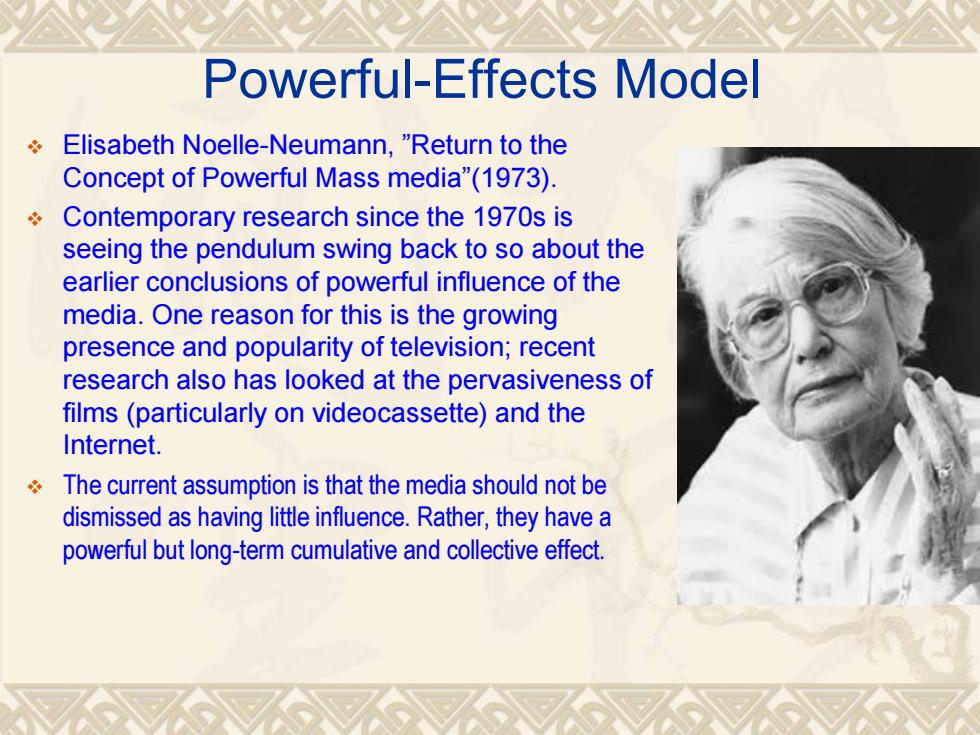
Powerful-Effects Model Elisabeth Noelle-Neumann,"Return to the Concept of Powerful Mass media"(1973). Contemporary research since the 1970s is seeing the pendulum swing back to so about the earlier conclusions of powerful influence of the media.One reason for this is the growing presence and popularity of television;recent research also has looked at the pervasiveness of films(particularly on videocassette)and the Internet. The current assumption is that the media should not be dismissed as having little influence.Rather,they have a powerful but long-term cumulative and collective effect
Powerful-Effects Model Elisabeth Noelle-Neumann, ”Return to the Concept of Powerful Mass media”(1973). Contemporary research since the 1970s is seeing the pendulum swing back to so about the earlier conclusions of powerful influence of the media. One reason for this is the growing presence and popularity of television; recent research also has looked at the pervasiveness of films (particularly on videocassette) and the Internet. The current assumption is that the media should not be dismissed as having little influence. Rather, they have a powerful but long-term cumulative and collective effect
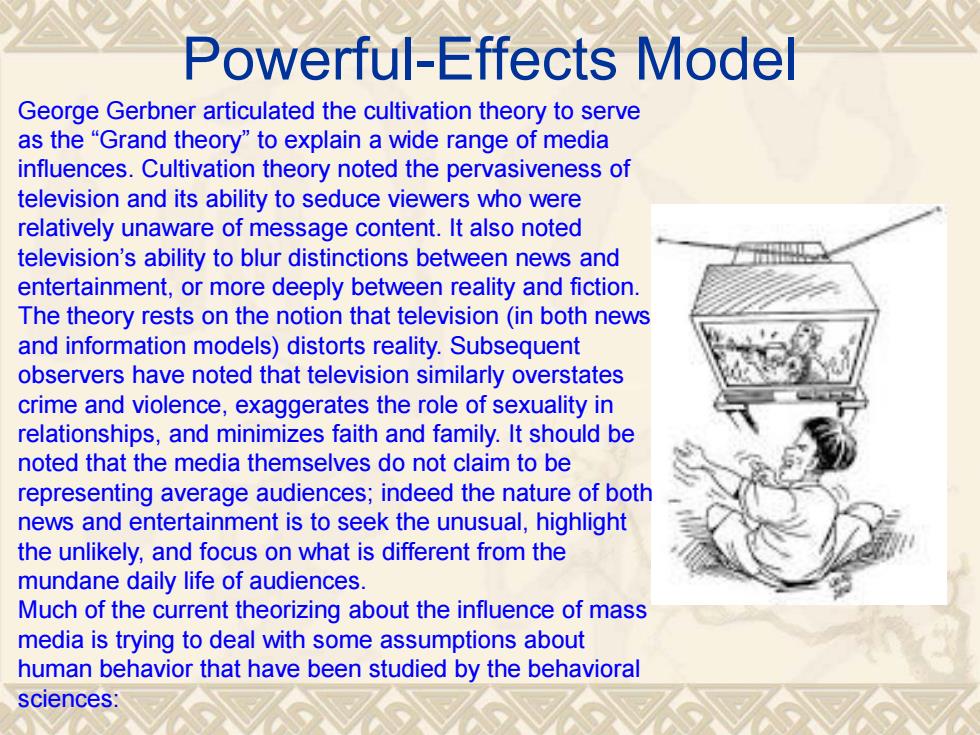
Powerful-Effects Model George Gerbner articulated the cultivation theory to serve as the "Grand theory"to explain a wide range of media influences.Cultivation theory noted the pervasiveness of television and its ability to seduce viewers who were relatively unaware of message content.It also noted television's ability to blur distinctions between news and entertainment,or more deeply between reality and fiction. The theory rests on the notion that television(in both news and information models)distorts reality.Subsequent observers have noted that television similarly overstates crime and violence,exaggerates the role of sexuality in relationships,and minimizes faith and family.It should be noted that the media themselves do not claim to be representing average audiences;indeed the nature of both news and entertainment is to seek the unusual,highlight the unlikely,and focus on what is different from the mundane daily life of audiences. Much of the current theorizing about the influence of mass media is trying to deal with some assumptions about human behavior that have been studied by the behavioral sciences:
Powerful-Effects Model George Gerbner articulated the cultivation theory to serve as the “Grand theory” to explain a wide range of media influences. Cultivation theory noted the pervasiveness of television and its ability to seduce viewers who were relatively unaware of message content. It also noted television’s ability to blur distinctions between news and entertainment, or more deeply between reality and fiction. The theory rests on the notion that television (in both news and information models) distorts reality. Subsequent observers have noted that television similarly overstates crime and violence, exaggerates the role of sexuality in relationships, and minimizes faith and family. It should be noted that the media themselves do not claim to be representing average audiences; indeed the nature of both news and entertainment is to seek the unusual, highlight the unlikely, and focus on what is different from the mundane daily life of audiences. Much of the current theorizing about the influence of mass media is trying to deal with some assumptions about human behavior that have been studied by the behavioral sciences: